Related Research Articles
Distributed generation, also distributed energy, on-site generation (OSG), or district/decentralized energy, is electrical generation and storage performed by a variety of small, grid-connected or distribution system-connected devices referred to as distributed energy resources (DER).
Wade, WADE, or Wades may refer to:
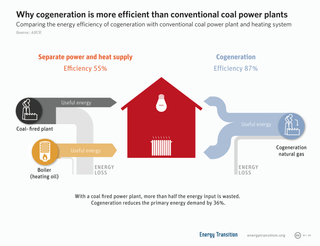
Cogeneration or combined heat and power (CHP) is the use of a heat engine or power station to generate electricity and useful heat at the same time. Trigeneration or combined cooling, heat and power (CCHP) refers to the simultaneous generation of electricity and useful heating and cooling from the combustion of a fuel or a solar heat collector. The terms cogeneration and trigeneration can also be applied to the power systems simultaneously generating electricity, heat, and industrial chemicals.

The Public Utility Regulatory Policies Act is a United States Act passed as part of the National Energy Act. It was meant to promote energy conservation and promote greater use of domestic energy and renewable energy. The law was created in response to the 1973 energy crisis, and one year in advance of a second energy crisis.

District heating is a system for distributing heat generated in a centralized location through a system of insulated pipes for residential and commercial heating requirements such as space heating and water heating. The heat is often obtained from a cogeneration plant burning fossil fuels or biomass, but heat-only boiler stations, geothermal heating, heat pumps and central solar heating are also used, as well as heat waste from nuclear power electricity generation. District heating plants can provide higher efficiencies and better pollution control than localized boilers. According to some research, district heating with combined heat and power (CHPDH) is the cheapest method of cutting carbon emissions, and has one of the lowest carbon footprints of all fossil generation plants.
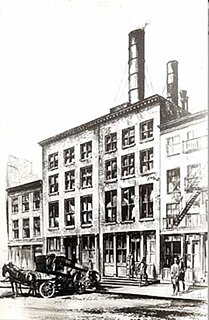
Pearl Street Station was the first commercial central power plant in the United States. It was located at 255-257 Pearl Street in the Financial District of Manhattan, New York City, just south of Fulton Street on a site measuring 50 by 100 feet. The station was built by the Edison Illuminating Company, under the direction of Francis Upton, hired by Thomas Edison.
This refers to the Directive on the promotion of cogeneration based on a useful heat demand in the internal energy market and amending Directive 92/42/EEC, officially 2004/8/EC and popularly better known as the 'Combined Heat and Power (CHP) Directive'.

Sugarcane or sugar cane refer to several species and hybrids of tall perennial grass in the genus Saccharum, tribe Andropogoneae, that are used for sugar production. The plants are two to six metres tall with stout, jointed, fibrous stalks that are rich in sucrose, which accumulates in the stalk internodes. Sugarcanes belong to the grass family, Poaceae, an economically important flowering plant family that includes maize, wheat, rice, and sorghum, and many forage crops. It is native to the warm temperate to tropical regions of India, Southeast Asia and New Guinea.
Energy recycling is the energy recovery process of utilizing energy that would normally be wasted, usually by converting it into electricity or thermal energy. Undertaken at manufacturing facilities, power plants, and large institutions such as hospitals and universities, it significantly increases efficiency, thereby reducing energy costs and greenhouse gas pollution simultaneously. The process is noted for its potential to mitigate global warming profitably. This work is usually done in the form of combined heat and power or waste heat recovery.
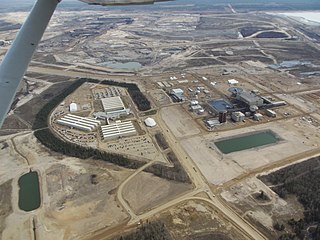
Albian Sands Energy Inc. is the operator of the Muskeg River Mine and Jack Pine Mine, an oil sands mining project located 75 kilometres (47 mi) north of Fort McMurray, Alberta, Canada. It is a joint venture between Shell Canada (10%), CNRL (70%) and Chevron Canada (20%). The company's legal headquarters are located in the Shell Tower in Calgary, Alberta. Albian Sands got its name from the Albian Boreal Sea which, during the Albian stage of the Cretaceous, moved over the McMurray sands and deposited a blanket of marine shale on its floor which trapped the hydrocarbons of the McMurray Formation. The oil sands resources of the Muskeg River Mine are a legacy of the Albian Sea.
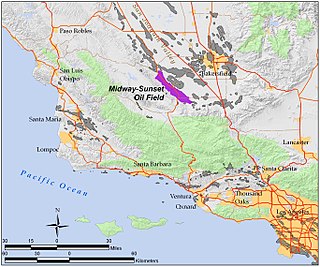
The Midway-Sunset Oil Field is a large oil field in Kern County, San Joaquin Valley, California in the United States. It is the largest known oilfield in California and the third largest in the United States.
The Midland Cogeneration Venture (MCV) is a natural gas-fired electrical and steam co-generation plant in Midland, Michigan owned by Midland Cogeneration Venture Limited Partnership. When it began operation in 1991, it was the largest gas-fired steam recovery power plant in the world.

Caterpillar Energy Solutions GmbH, is a mechanical engineering company based in Mannheim, Baden-Württemberg, Germany. It was known as MWM GmbH Motoren-Werke Mannheim (MWM) until November 2013. In 2009 the company was the third-largest producer by revenue of gas and diesel engines.

Thor Cogeneration is a planned, but undeveloped, gas-fired cogeneration plant, which was to be built on Seal Sands near Billingham, in County Durham, North East England.

Steam is water in the gas phase. It is commonly formed by boiling or evaporating water. Steam that is saturated or superheated is invisible; however, "steam" often refers to wet steam, the visible mist or aerosol of water droplets formed as water vapour condenses.

Recycled Energy Development, LLC (RED) aims to profitably reduce greenhouse gas emissions by capturing and recycling waste energy, especially through cogeneration and waste heat recovery.
Thomas R. Casten is an American businessman, author, and activist known for his work on industrial energy recycling. Since 1977, Casten has founded and managed numerous companies and organizations associated with combined heat and power, decentralized energy, and waste energy recovery.

Stadtwerke München GmbH or SWM is a German communal company, owned by the city of Munich, which offers public services for the city and the region of Munich. The company supplies electricity for more than 95% of Munich's 750.000 households as well as natural gas, drinking water and, through its stake in the M-net Telekommunikations GmbH, telecommunications services. SWM is Europe's largest municipal utility company and ranks among Germany's principal energy providers according to company information. Expanding use of renewable energy has been a central element in the company's strategy since 2008. However, the company is also engaged in the industrialisation of the Norwegian wilderness through massive wind-turbines, which has created great opposition in Norway, among others in Sørmarka, Trøndelag.
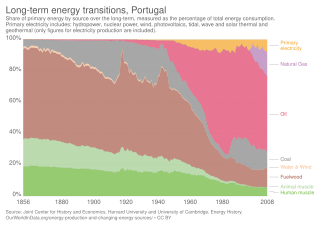
Energy transition is a significant structural change in an energy system. Historically, these changes have been driven by the demand for and availability of different fuels. The current transition to renewable energy, and perhaps other types of sustainable energy, differs as it is largely driven by a recognition that global carbon emissions must be brought to zero, and since fossil fuels are the largest single source of carbon emissions, we must change energy systems worldwide to replace fossil fuels.
References
- ↑ Cohen, Nevin (2011). Green cities : an A-to-Z guide. Thousand Oaks: Sage Publications. p. 497. ISBN 978-1412996822.